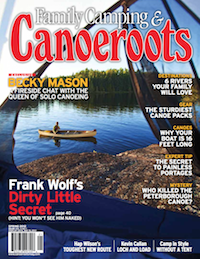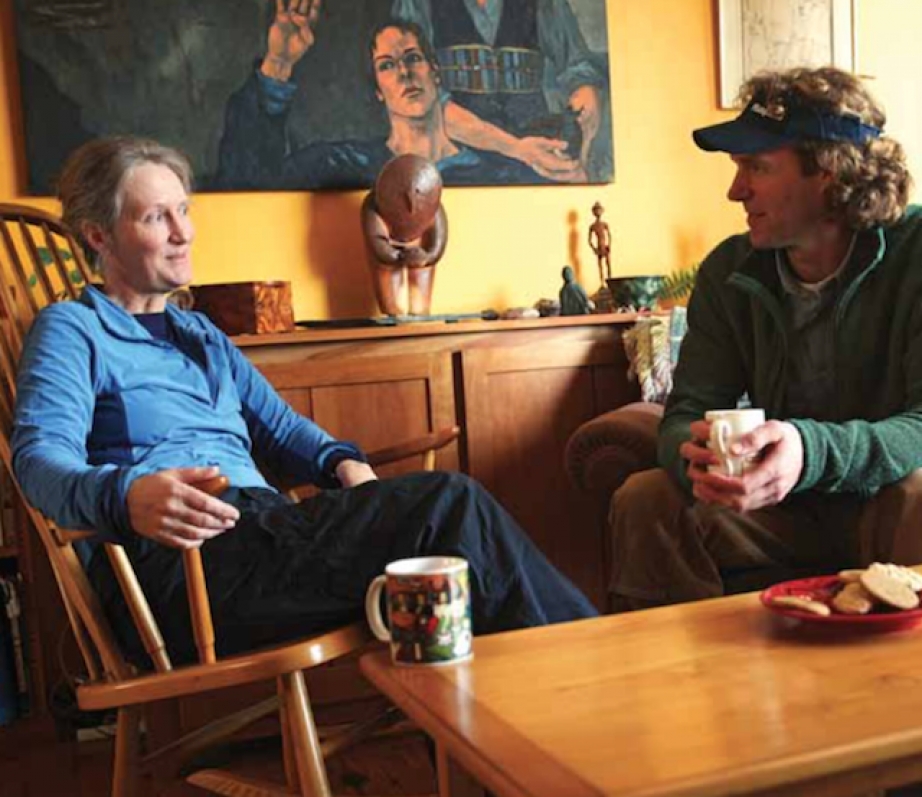In 2011, Becky Mason toured Europe for six weeks celebrating the release of her third film, Advanced Classic Solo Canoeing. Bridging the cultural gap with canoes was an enlightening experience 11 years in the making.
Mason’s ongoing work with the global canoeing community is founded on a passion for teaching and her father’s legacy.
Q: It’s been 11 years since you released your last film, but this one feels like it’s built on a lifetime of experiences. Tell us more about the person in the famous red cedar-canvas prospector.
A: I’m a creative artist. That’s what i say when people ask me what I am. But there are lots of other hats that I wear in life. I’m a watercolorist. I love the creative side of canoeing, just doing all those gorgeous strokes. and, now, filmmaking—I’ve done three films. I do what makes me tick.
Q: Instructing must make you tick, then.
A: I love teaching. I love sharing knowledge with people—how to go canoeing and how to go canoeing efficiently. People’s eyes light up when they see that they can make the canoe move more efficiently without much effort.
Q: Your path is similar to your father Bill Mason’s career in canoeing, filmmaking and fine art. Do you feel overshadowed by his legacy?
A: I miss my dad. People ask if it’s hard following in his footsteps and I say no because it’s really special. I have some characteristics of his and I’m good with that. When I was 18, I found it a bit difficult handling the whole fame thing. He was having dinner with the Queen, he was traveling, the phone was always ringing. People would come up to me and say, “You’re Bill Mason’s daughter, I can’t believe I’m meeting you.” I always thought to myself, “Yeah, but I’m a person too, in my own right.”
When I turned 19, I came into my own and realized that I could either divorce myself from his legacy or accept it and build on it. And that’s what I do. I’m building on his skills that he taught me.
Q: You share some of those skills in your new DVD.
A: Since I completed my last film, I’ve been building on that knowledge and my teaching technique has changed and improved because I’ve had a lot of interaction with people.
Every stroke covered—all 18 of them—I broke down into parts: first, an introduction covering why people need the strokes; then, I break them down in detail; the last part includes additional information like why I love the stroke and why people think it’s special. It is a neat way to cover the strokes. You’re getting a lot of information but it’s also enjoyable to hear the stories behind them.
You also get to see the thread of the stroke. It’s very important in advanced paddling to see the continuation of where you’re going and how the movement of your body and the blade are interacting.
Q: Not only do you package each stroke and present it well, the images are extremely pleasing to watch. How has your filmmaking evolved?
A: I really wanted to shoot my last film in 16mm, but it was too expensive in 2000. For this one, the digital age is upon us, so it was cheap. I filmed in high definition with a camera I rented. The color was beautiful, and I was able to pick the light levels. I’m a traditional filmmaker. I love picking light levels and letting the scenes breathe.
Location is the most important thing for a movie. I really felt strongly that i wanted to go up to Lac Vert in Quebec. When you look down, you can see up to 60 feet deep, clear as a bell. I wanted to capture that in underwater shots. It was amazing to pick a location that inspired me to get the underwater shots.
I tried underwater shots in my first movie. I dragged Jerry, my editor, around Meech Lake on a rope with a SCUBA diving apparatus and it just didn’t work. The camera blew up right when I was about to edit. This time around, I was bound and determined to get underwater shots. It’s just so beautiful to see underneath and above.
Q: Does that enhance your ability to teach the stroke?
A: I’ve had so many comments from people who now understand what the blade is doing because they get to see it from below.
I also wanted to inset the canoeing in nature. With the underwater shots you see the beautiful white-bottomed lake. The calcium carbonate just shimmers. And then you have all the fish swimming in the lake. It’s great to show nature interacting with the strokes.
Q: This time around, you chose to launch your film in Europe first. How did that come about?
A: When I’m out canoeing, I dream a lot. It’s really beautiful canoeing at home on Meech Lake, but I like to share my skill, my love of canoeing. I get lots of requests from around the world asking me to come and teach. So, I went online to a European paddling forum and said I’d like to come to five countries and welcomed paddling clubs to invite me. Within a day, five paddling clubs piped up from the netherlands, Belgium, France, Germany and italy.
Q: Your reputation preceded you. Is there an established canoeing scene in those countries?
A: It was great! We were concerned there wouldn’t be enough paddlers in the netherlands, but I planned two classes during the day and a presentation at night, and we were able to go and teach in their beautiful country.
The Italians all knew Bill Mason’s Path of the Paddle. I teach a lot of people who have only learned from my dad’s books and it’s quite charming because some of the interpretations get a little interesting. They were so fixated. They thought the only canoe in the world was a prospector because Bill Mason said so. They followed his words to a T.
Q: Not too much culture shock then?
A: It was a good stretch. I learned to use pantomiming to teach canoeing. Canoeing is a universal language. I really learned that on the European trip because I was going through all the languages—Flemish, French, Italian, German.
The whole of Europe was so generous and kind to us. In France they laid out a huge long table with white tablecloths and champagne flutes. We were drinking champagne and eating paté all afternoon. It was great.
Q: A far cry from a bagel with cream cheese and a bag of GORP. So what’s next?
A: My husband Reid, who coproduced the DVD with me, doesn’t know this yet but I’m going to go across North America this summer. I did it in 2006 and it’s about time I go again. I’ll take my DVD and do what I did in Europe, buzzing along the border between the U.S. and Canada, visiting all the clubs. I don’t know when I’m going to tell Reid. I’ll spring it on him; he tends to do better that way.
Interview by Scott MacGregor. Edited by Michael Mechan.
Becky Mason’s Advanced Classic Solo Canoeing
The 43-minute film builds on Mason’s wildly successful instructional film Classic Solo Canoeing, taking paddlers for a spin in her cedar-canvas canoe on the crystal clear waters of Lac Vert, Quebec. She shares 18 expert strokes and maneuvers along with stories of nature, heritage and her past. Stunning underwater camera angles provide a unique view of techniques like the Canadian stroke, the Indian stroke and the Northwood—a stroke not covered in depth on video until now.
Special features include a six-minute bonus musical paddling video with folk artist Ian Tamblyn, outtakes from the main production and Mason’s complete original film, Classic Solo Canoeing.
Advanced Classic Solo Canoeing won the Best Instructional Paddling Film award at the 2012 Reel Paddling Film Festival.
Purchase the DVD online from redcanoes.ca

This article first appeared in the Spring 2012 issue of Canoeroots Magazine.




